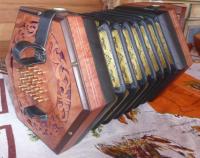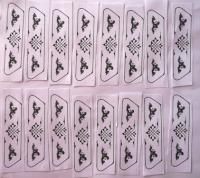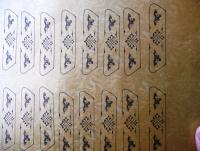
chris salty-dog vonderborch
Members-
Posts
33 -
Joined
-
Last visited
About chris salty-dog vonderborch
- Birthday 03/20/1934
Contact Methods
-
Website URL
http://
Profile Information
-
Interests
I am a Marine Geologist by profession, now largely retired in the forests of southeastern Tasmania! At my ripe age, I still SCUBA dive, surf, sail and kayak, and when the weather closes in, I am to be found in my workshop, making musical instruments. I tend to oscillate between classic guitars, celtic harps, banjos, ukuleles, and, of course, concertinas. We use all of these for folk events, including sea shanty singing. I am involved with the construction of my fifth concertina, having previously made an English, 2 Anglo C/G's, and an Anglo G/D.
-
Location
Tasmania
chris salty-dog vonderborch's Achievements

Advanced Member (3/6)
-
Did you lose much thickness when they repolished it? That would be my worry, that they ended up thin enough to deform in use. I was careful to give the platers a real grilling on that matter, and also concerning the horror possibility of a buff catching the fretwork and hurling a distorted piece of valuble metal against the factory wall!! In actual fact it all ended up very well done. They carefully buffed away the old nickle, which was part-way off anyway, and also buffed out some tiny pits in the monel-metal. The bottom line is that they are almost as thick as formerly, and look great. (Chris)
-
I am of the opinion that nickle-plating is the traditional method of treating concertina ends. I have just restored a Wheatstone Aeola with metal ends. The nickle was worn in places, so I had them re-plated in Hobart. They were first cleaned and carefully buffed, then copper followed by nickle plated. They now look great. However, it is wise to ensure that the plating is not too thick. I once saw a nice Crabb anglo compromised by overdone plating, which spoiled the crisp fretwork.
-
I am beginning the job of restoring a c.1905 Aeola, which has a magnificent set of reeds and reed-pans. I want to do a careful and responsible job on this antique instrument. A fair amount of ebony-work is required, apart from other stuff! So I have soaked the old bellows and separated the components. I found some interesting things. For example, the "top-runs" are composed of 2 layers of thin leather, not the usual (in most concertinas) single layer. Is that normal for the Aeola? And of course, the bellows are austere black all over; no fancy bellows papers; rather funereal, but I guess that was how the Aeolas were designed. So I guess I should make the new bellows the same; would others agree? The raised metal ends are in good shape, but need a re-plate. I think I will clean them up with wet/dry emery and steel wool before having them re-plated. I guess it should be nickle-plating. I did have the ends of one concertina that I made silver plated, with a special baked-on protective coating which has survived well. What would the forum think of that?? Ideas gratefully received. I do want to do justice to the instrument!
-
I have just had the good fortune of receiving a box full of the partly dismembered bits of a metal-ended Wheatstone Aeola English. I will make new bellows and re-do the ebony veneering etc. The reeds and pans are in exquisite shape, so it should turn out to be a nice instrument. My question: I can't locate the web-site that lists dates of manufacture of Wheatstones against serial numbers. Can anyone help? The serial number is: 24012.
-
Current makes of concertina
chris salty-dog vonderborch replied to Daniel Hersh's topic in General Concertina Discussion
Hi Daniel, Maybe I could be added to the current list of concertina-makers. Chris vonderBorch, Tasmania. Makes vintage traditional concertinas with hand-made reeds. Mainly English and some Anglo concertinas Not a commercial maker; basically an "experimenter" seeking the "Holy Grail" -
An establishment you can visit to have your documents duplicated by xerography. Er, that is, a copy shop--hereabouts (Massachusetts) that's usually a UPS Store, a Staples office supply store (they generally have copy/print shops in the back) or a FedEx Office (formerly FedEx Kinko's, formerly Kinko's). I don't know what the usual suspects are east of the North Atlantic, but no doubt you have some idea... jdms Down here south of the equator, we Aussies call a "photocopy Shop" a "Xerox Shop", just as we call those animals that look a bit like deer "Kangaroos"
-
It is easy, using modern technology, to design and make high quality bellows papers. I will outline the method: First of all, design the pattern, and draft it up about 2 times larger than required. I use a "clip-art" design book for suitable patterns, but one could source such patterns on the internet also. I cut out selected bits of the scrolls and arrange them within the outline of the pattern; I glue them with a glue-stick, then erase any unwanted blotches with "white-out" Next, decide on the final size of the papers; mark the required width on a piece of scrap paper. Take this to your local Xerox shop and they will scale down the drawing to fit the size required. Then ask them to "clone" the pattern; you will get several copies of the pattern to scale, on an A4 sheet. I copy this 2-3 times, then cut out the pieces and glue them close together onto a master A4 sheet, maybe 20 to a sheet. This is the "master sheet". From a "fancy paper" shop, select the colour desired as background. I selected a dull patterned gold style in A4 size, and purchased a packet of 10 sheets. The paper is listed as being compatible with laser jet printers. Back to the Xerox shop! The kind assistant then will print the master onto the gold sheets until you have in XS of 96 copies (for 7-fold bellows). You cut these out individually with scissors whilst listening to Irish concertina music, and glue them onto the bellows!
-
I am about to make a replacement set of bellows for a venerable Wheatstone Duet. However, I have not purchased suitable leather for several years, having had a good stock, now depleted, of skived kangaroo leather. So...does anyone know where I could mail-order the best leather for the job? I am looking for 0.4-0.5mm thick skived leather. I have heard thet there is a place in the UK that will send ready skived leather for bellows.
-
I have now made 16 of the 96 reeds, and can play partly in the key of D! The baritone does have a satisfactory "growl" in its bass notes, so I am happy so far. I did need to thin down some of the higher reeds, to make them playable, with good results. I use, as a guide, detailed measurements of thicknesses of the reeds from an excellent Jeffries, whose reeds have never been modified (ie. the initial grinding marks still showing). But I should have remembered, from former concertina projects, that I always needed to go several percent thinner than the Jeffries for playability, using my steel. Anyway, I attach a photo of the beast as it is, fully bellowed and ready for several months of "voicing".
-
I am well into the laborious but interesting (and yes, exciting) process of making the reeds for the baritone. The count is now 14 out of 96. Also, my former skill level (such as it is) is returning. I have made around 300 reeds in past years, for former projects, but the last was 3 or so years ago, so now I feel I am back into filing practise...a reed fitted and tuned, to close tolerance, in half an hour (sometimes). If my computer skills are up to it, I will attach a photo of my "precision" shoe-filing jig. What I have been doing is to use the jig to true up the slot and its several degree downward relief. I find that the jig, which the photo will show to be largely self-explanatory,produces a perfect slot, using a dedicated file which has been thinned down appropriately on its back side. The file has a nylon block attached, which essentially slides along an adjustable platform. The brass shoes were produced by a CNC milling set-up, and the slots were initially parallel-sided into the slot. So first, I blacken the slot with texta, and clamp it in the vice. I then carefully file the slot until I get a knife-sharp edge, similar to what I have observed on some well-known concertinas. I then clamp a piece of reed steel (old surveyors measuring "chain", in fact) in the vice, and file one edge perfectly flat by filing along the steel...not "draw-filing". I then turn the reed steel over in the vice, and I find that I can file the taper quite accurately with practise. I maybe make one or two slight adjustments, then I check it in the shoe, using a head magnifier or, sometimes, a binocular microscope (thanx, Chris Ghent!!). Then I file the desired profile, starting at the tip to get it to the desired thickness, as per studies of reeds from well established instruments. Then, of course, tuning!! Nothing surprising there! One thing that I THINK I have noticed, tho' it could be a subjective observation, is that the new reeds sound better after resting, or being exercised, for a couple of hours after filing. This could be imagination, but my feeling is that it is real. Maybe Dana could shed light on this?? Doed the steel relax???after stressing??? I will leave it there.
-
Some of you may recall my postings of several months ago, concerning my long-term project, the building of a baritone English concertina. The construction was interrupted by 2 1/2 months wandering the Indian Himalayas. However, I am now back in my Tasmanian workshop, and the project continues. I have just made the bellows and set up the action. Now comes the exciting bit...making its first sound!! I intend to be extra meticulous with the reeds, endeavouring to attain very close tolerances for playability and tonal quality. So I designed a reed shoe filing jig which ensues that the slots are very accurate. It has worked well for the first 6 reeds, so I will post a photo of the jig soon. Accurate slots made it relatively easy to fit the steel reeds, with the desired tolerance of less than 2 thousands of an inch. But the first reeds took me a long time, as I am somewhat out of practise! In fact, I only made and fitted 2 on day one! I am getting faster with practise, and only have 90 of the little things to go. The good news is that the concertina sounds really sweet, which is what I was aiming for!!





